I recently received a request – thanks Chris – for an update about a landscape pine on its way to becoming a bonsai. Here’s what the tree looked like in 2012.

January, 2012 (see Part 1 and Part 2 for the rest of the story)
After removing the top half of the tree and repotting, the tree did well for a while but showed signs of stress a year later when two of the remaining three branches died. This made me concerned about the roots. The next year I repotted the tree to see what was going on in the soil.
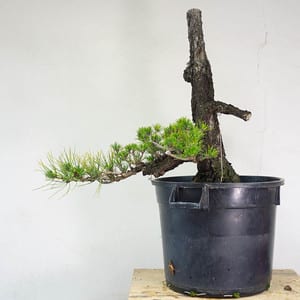
December, 2014
After removing the tree from the pot, it was easy to see that a lot of roots had grown on one side of the pot. Looking closer, however, it became clear that the roots were no longer growing – and that there were signs of root aphids.
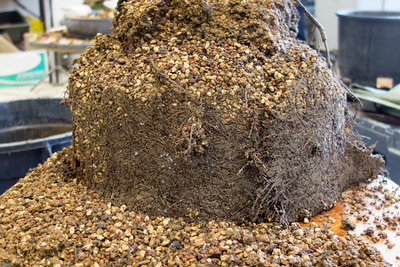
The previous years’ roots
The other side of the rootball showed no new root growth.
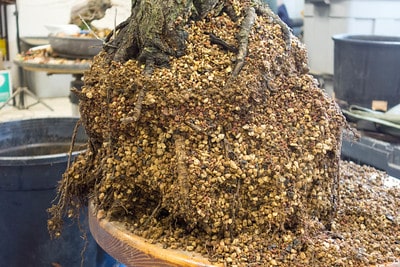
No signs of life
We all know that stressing trees makes them more susceptible to infestation. What I did not know at the time was that hidden infestations were just as dangerous as visible infestations. As I poked gently at the rootball, most of the soil fell away. Very quickly I realized the tree had only a few living roots.
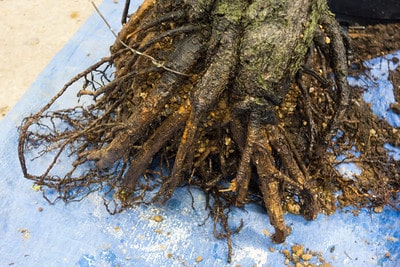
No living roots on this side
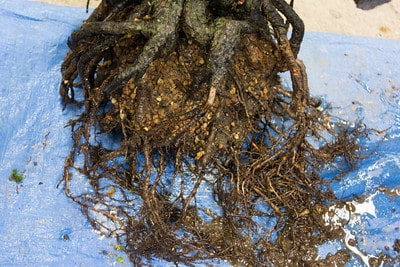
The only living roots
I did the repotting in a Bay Island Bonsai workshop. No one was very optimistic about the prognosis. I repotted the tree in a much smaller pot with medium-sized soil.
The aftercare was simple – don’t water the tree until it dried out. Every day when I watered, I sprinkled the foliage lightly but not enough to wet the soil. As there were very few roots, the soil remained wet just an inch from the surface. As a result, I watered the tree less than once a month – even in summer.
The tree grew very little last year, but this spring new candles have opened right on schedule.
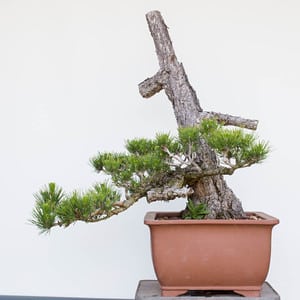
April, 2016
I don’t feel like I’m out of the woods yet, but it is good to see some new growth. I’ll fertilize more this year and let the tree grow freely until it regains its vigor. Although I don’t plan to use them in the future, the dead trunk and branch stubs will remain for now.
The weed growing at the base of the trunk, by the way, is a spiral orchid. They seem to love growing at the base of pines and have showed up in several of mine over the years.
Subscribe to Bonsai Tonight
New Posts Delivered Every Tuesday and Friday
sdavis says
Do you have some photos of other niwaki that you turned into bonsai?
Jonas Dupuich says
Here is another garden tree on its way to becoming a bonsai:
https://bonsaitonight.com/2015/04/14/repotting-black-pine-in-nursery-soil/
https://bonsaitonight.com/2015/04/10/cleaning-up-a-black-pine/
And here’s what it looked like after the first big cut:
https://dupuich.smugmug.com/Bonsai/Development/JapaneseBlackPine/i-hrg8WC8
evanmb says
What’s your go to method for fighting root aphids?
Vern Maddox says
Interesting and informative information. Looks like you may have saved this one and it may turn into an interesting bonsai in the future. I like it.
Root aphids aren’t as much of a problem in Texas, but not unknown. How did you deal with those scary little buggers?
Vern
Susan Daufeldt says
Did removing the old soil and repotting take care of the root aphids or did you do something else?
Jonas Dupuich says
After removing the old soil, I didn’t see further evidence of root aphids so I didn’t treat for them. As for what to do about them: https://bonsaitonight.com/tag/root-aphids/
Brian Schindler says
Jonas
In the article you said that you watered less than once a month. I assume this was a typo and you meant that you watered less than once a day.
Jonas Dupuich says
Hi Brian, thanks for the note! While I sprinkled the foliage every day, I didn’t water the way I normally would more than once per month. I checked the soil about an inch down every few days and didn’t water until it was starting to dry out down there. Sprinkling the foliage every day provided some moisture to the soil and I think that was just enough.
Chris Nelson says
Thanks for the shout out-and the info and pics- Jonas! Both trees give me inspiration, and also remind me to practice patience when trying to make a silk purse (beautiful pine bonsai) from a sow’s ear (nursery pine grown for landscaping). It is easy to be impatient and expect too much, too soon, especially with these as the starting material. Keep up the great posts!